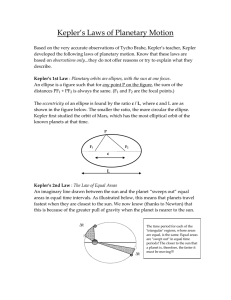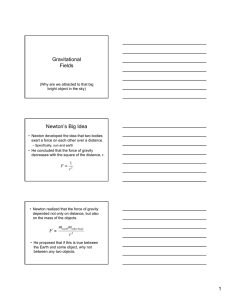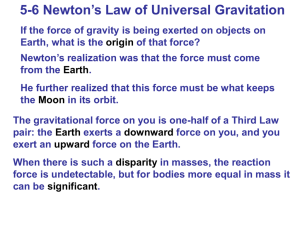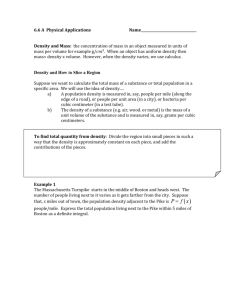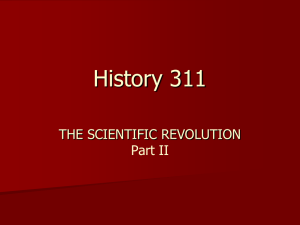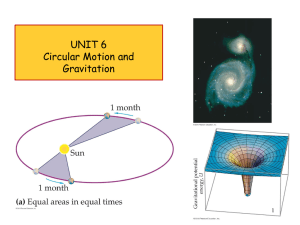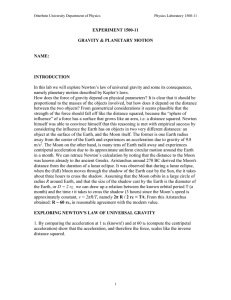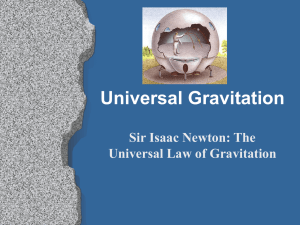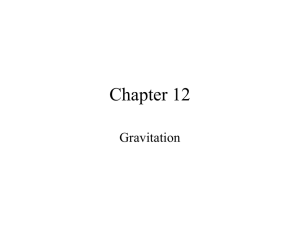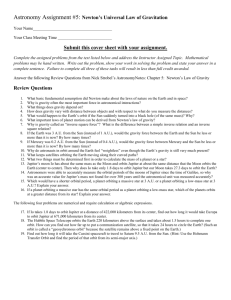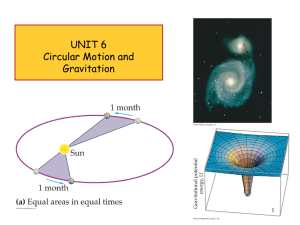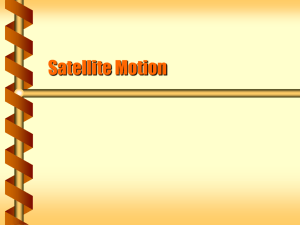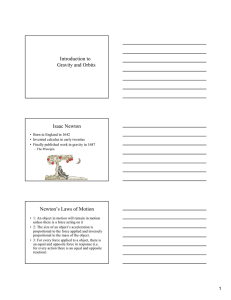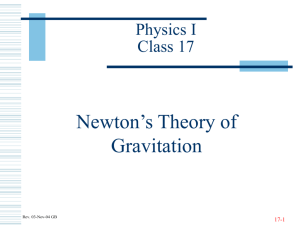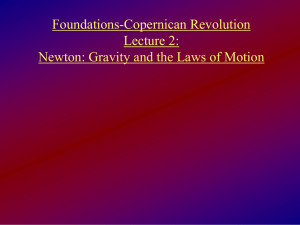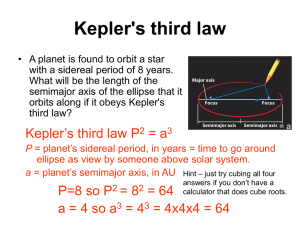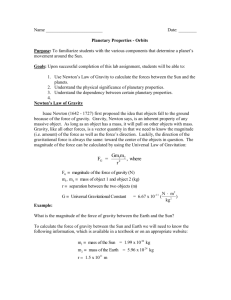Ppt
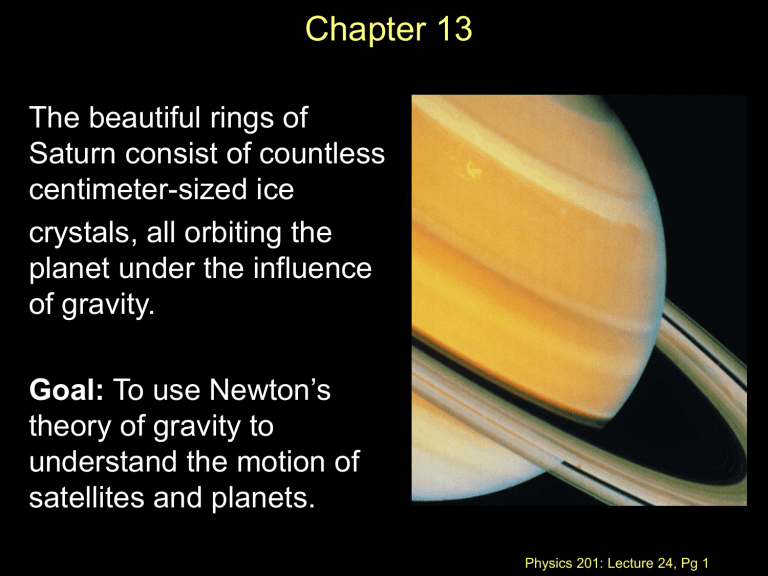
Chapter 13
The beautiful rings of
Saturn consist of countless centimeter-sized ice crystals, all orbiting the planet under the influence of gravity.
Goal: To use Newton’s theory of gravity to understand the motion of satellites and planets.
Physics 201: Lecture 24, Pg 1
Who discovered the basic laws of planetary orbits?
A. Newton
B. Kepler
C. Faraday
D. Einstein
E. Copernicus
Physics 201: Lecture 24, Pg 2
What is geometric shape of a planetary or satellite orbit?
A. Circle
B. Hyperbola
C. Sphere
D. Parabola
E. Ellipse
Physics 201: Lecture 24, Pg 3
The value of g at the height of the space shuttle’s orbit is
A. 9.8 m/s 2 .
B. slightly less than 9.8 m/s 2 .
C. much less than 9.8 m/s 2 .
D. exactly zero.
Physics 201: Lecture 24, Pg 4
Newton’s Universal “Law” of Gravity
Newton proposed that every object in the universe attracts every other object.
The Law: Any pair of objects in the Universe attract each other with a force that is proportional to the products of their masses and inversely proportional to the square of their distance
Physics 201: Lecture 24, Pg 5
Newton’s Universal “Law” of Gravity
F on 2 by 1
G m
1 m
2 r 2 rˆ
12
F on 1 by 2
“Big” G is the Universal Gravitational Constant
G = 6.673 x 10 -11 Nm 2 / kg 2
Two 1 Kg particles, 1 meter away F g
= 6.67 x 10 -11 N
(About 39 orders of magnitude weaker than the electromagnetic force.)
The force points along the line connecting the two objects.
Physics 201: Lecture 24, Pg 6
Newton’s Universal “Law” of Gravity
You have three 1 kg masses, 1 at the origin, 2 at (1m, 0) and 3 at
(0, 1m). What would be the Net gravitational force on object 1 by objects 2 & 3?
G = 6.673 x 10 -11 Nm 2 / kg 2
Two 1 Kg particles, 1 meter away F g
= 6.67 x 10 -11 N
Each single force points along the line connecting two objects.
F on 2 by 1
G m
1 m
2
rˆ
12
F on 1 by 2 r 2
F on 3 by 1
G m
1 r m
2
2
rˆ
13
F on 1 by 3
F g
=9.4 x 10 -11 N along diagonal
Physics 201: Lecture 24, Pg 7
Motion Under Gravitational Force
Equation of Motion m d
2
r ( t ) dt 2
G
Mm r 2 rˆ
If M >> m then there are two classic solutions that depend on the initial r and v
Elliptical and hyperbolic paths
Physics 201: Lecture 24, Pg 8
a: Semimajor axis
b: Semiminor axis
c: Semi-focal length
a 2 =b 2 +c 2
Eccentricity e = c/a
Anatomy of an ellipse x a 2
2
y b 2
2
1
If e = 0, then a circle
Most planetary orbits are close to circular.
Physics 201: Lecture 24, Pg 9
A little history
Kepler’s laws, as we call them today, state that
1. Planets move in elliptical orbits, with the sun at one focus of the ellipse.
2. A line drawn between the sun and a planet sweeps out equal areas during equal intervals of time.
3. The square of a planet’s orbital period is proportional to the cube of the semimajor-axis length.
Focus Focus
Physics 201: Lecture 24, Pg 10
Kepler’s 2 nd Law
The radius vector from the sun to a planet sweeps out equal areas in equal time intervals (consequence of angular momentum conservation).
Why?
m d 2
r ( t ) dt 2
G
Mm r 2 rˆ
Physics 201: Lecture 24, Pg 11
Conservation of angular momentum
dA dA dt
dA dA
1
2
|
1
2 r
| A
C |
d r
1
2
|
d r r
v
|
|
v dt dt
AC sin
| r
(
m v ) | dt m
2
1 m
| r
p |
|
L |
L is constant (no torque)
A
C
Physics 201: Lecture 24, Pg 12
Kepler’s 3
rd
Law
Square of the orbital period of any planet is proportional to the cube of semimajor axis a.
F
Centripeta l
ma c
G
M
Sun m r
2
T 2
4
2
GM
Sun a c
v 2 r
r
2
r (
2
T
) 2 a 3 r (
2
T
)
2
G
M
Sun r 2 r 3
T 2
Physics 201: Lecture 24, Pg 13
Little g and Big G
Suppose an object of mass m is on the surface of a planet of mass M and radius R . The local gravitational force may be written as
F
G
mg surface where we have used a local constant acceleration:
F on m by M
mGM
R 2 rˆ
M , m g
surface
GM
R
2
On Earth, near sea level, it can be shown that g surface
≈ 9.8 m/s 2 .
Physics 201: Lecture 24, Pg 14
Cavendish’s Experiment
F = m
1 g = G m
1 m
1
/ r 2 g = G m
2
/ r 2
If we know big G , little g and r then will can find the mass of the Earth!!!
Physics 201: Lecture 24, Pg 15
Orbiting satellites v t
= (gr)
½
Net Force: ma = mg = mv t
2 gr = v t
2
/ r v t
= (gr)
½
The only difference is that g is less because you are further from the
Earth’s center!
Physics 201: Lecture 24, Pg 16
Geostationary orbit
Physics 201: Lecture 24, Pg 17
Geostationary orbit
The radius of the Earth is ~6000 km but at 36000 km you are
~42000 km from the center of the earth.
F gravity is proportional to 1/r 2 and so little g is now ~10 m/s 2 / 50
v
T
= (0.20 * 42000000)
At 3000 m/s, period T = 2
r / v
T
½
= 2
m/s = 3000 m/s
42000000 / 3000 sec =
= 90000 sec = 90000 s/ 3600 s/hr = 24 hrs
Orbit affected by the moon and also the Earth’s mass is inhomogeneous (not perfectly geostationary)
Great for communication satellites
(1 st pointed out by Arthur C. Clarke)
Physics 201: Lecture 24, Pg 18
All of Chapter 13
Tuesday
Physics 201: Lecture 24, Pg 19

